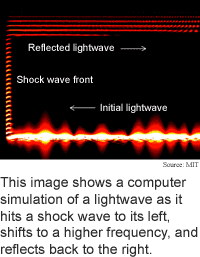
Shock waves tune light
By
Eric Smalley,
Technology Research NewsResearchers from the Massachusetts Institute of Technology have used a computer simulation to show that sending shock waves through photonic crystals could lead to faster and cheaper telecommunications devices, more efficient solar cells, and advances in quantum computing.
Photonic crystals are lattice structures or solids punctured with holes. These periodic patterns bend light so that only certain wavelengths can pass through.
The researchers showed that when a shock wave moves through a photonic crystal, it temporarily changes the spacings in a way that induces two surprising changes: a large Doppler shift, and a bandwidth narrowing. These effects "occur when light interacts with a photonic crystal while the geometry is actually changing," said Evan Reed, a researcher at MIT.
A physical shock wave can be produced by hurling a projectile or shooting a high-intensity laser at a crystal. A shock-wave-like effect can also be produced using sound waves or electricity.
The Doppler shift changes the frequency of lightwaves in a way similar to the familiar pitch change that happens in sound waves when a train goes by. The shock wave effect changes the size, or frequency, of lightwaves fairly drastically. The shift is 10,000 times greater than usual -- enough that the color of the lightwave changes visibly, according to Reed.
The effect can be used to efficiently convert light to frequencies that are useful for communications devices. High-speed communications signals carried over fiber-optic lines are made up of specific frequencies of light. Some frequencies travel more efficiently than others, and multiple signals made up of slightly different frequencies can be sent over the same line at the same time. The shock wave light-shift effect could be used to convert lightwaves generated by inexpensive light sources to frequencies carried more efficiently by optical fibers.
The second effect could lead to more efficient conversion of light to electricity. The shock wave efficiently narrows the bandwidth of the spectrum of light, an unusual effect that is potentially useful for harvesting solar energy, said Reed. "There are many physical systems that increase the bandwidth of light, but to our knowledge no existing classical systems are capable of narrowing the bandwidth of" any lightwave, he said.
The simulations showed that the bandwidth of a lightwave can be narrowed by squeezing it between a shock wave and a reflective surface.
The method could be used to narrow the spectrum of solar lightwaves entering photovoltaic materials, allowing the materials to convert more of the energy contained in the full spectrum of sunlight to electricity, according to Reed.
The frequency-shifting and bandwidth-narrowing effects are largely independent of the speed, shape and thickness of the shock wave, according to the researchers.
The researchers' simulations showed that the effects can be produced without literally using shock waves, which would be impractical. Anything that changes the photonic crystal's structure as a lightwave propagates through it will work, according to the researchers. "Methods involving nonlinear optical materials, acousto-optical materials or [microelectromechanical systems] devices are likely to be more useful than shock waves due to their non-destructive and repeatable nature," said Reed.
The effects could be used in some practical applications within a year, said Reed. Others will require 2-5 years.
The effects could also boost single-photon quantum information processing efforts, like quantum cryptography, according to Reed. Quantum computers use properties of particles like photons and atoms to represent information. Because photons are not absorbed and reemitted by the shock-wave-altered crystal, in theory, these quantum properties and thus information they represent can be preserved.
Quantum computers are theoretically much faster at certain tasks like searching large databases and cracking codes than any possible classical computer.
Reed's research colleagues were Marin Soljacic and John Joannopoulos. The work is scheduled to appear in an upcoming issue of Physical Review Letters. The research was funded by the National Science Foundation (NSF).
Timeline: > 1 year, 2-5 years
Funding: Government
TRN Categories: Optical Computing, Optoelectronics and Photonics; Materials Science and Engineering
Story Type: News
Related Elements: Technical paper, "The Color of Shock Waves in Photonic Crystals," slated to appear in Physical Review Letters.
Advertisements:
June 4/11, 2003
Page One
Shock waves tune light
Artful displays track data
Plastic transistors go vertical
Artificial beings evolve realistically
News briefs:
Microfluidics go nonlinear
Browser boosts brain interface
Semiconductor emits telecom light
3D display widens view
Study shows DNA will fill tubes
DNA part makes transistor

News:
Research News Roundup
Research Watch blog
Features:
View from the High Ground Q&A
How It Works
RSS Feeds:
News
Ad links:
Buy an ad link
| Advertisements:
|
 |
Ad links: Clear History
Buy an ad link
|
TRN
Newswire and Headline Feeds for Web sites
|
© Copyright Technology Research News, LLC 2000-2006. All rights reserved.